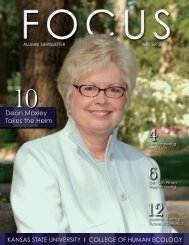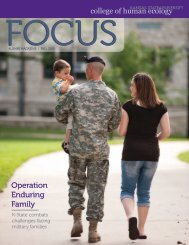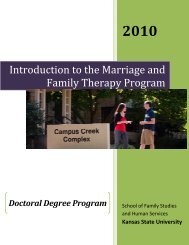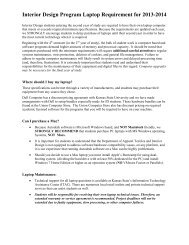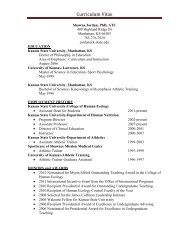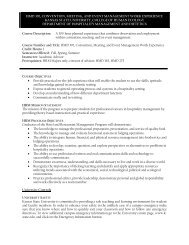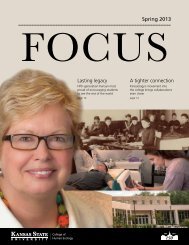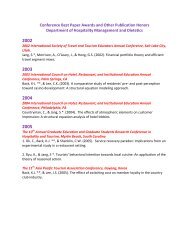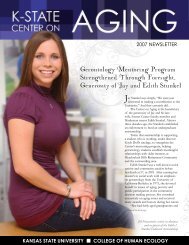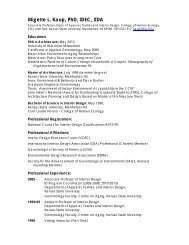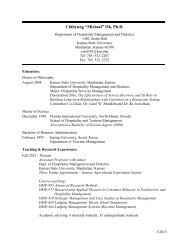chapter 4 - College of Human Ecology - Kansas State University
chapter 4 - College of Human Ecology - Kansas State University
chapter 4 - College of Human Ecology - Kansas State University
Create successful ePaper yourself
Turn your PDF publications into a flip-book with our unique Google optimized e-Paper software.
CHAPTER 4: DR. RUTH HOEFLIN AS DEAN<br />
Home Economics from 1975 to 1983<br />
In this <strong>chapter</strong>, most excerpts were taken from Ruth<br />
Hoeflin’s book, History <strong>of</strong> a <strong>College</strong>: From Woman’s<br />
Course to Home Economics to <strong>Human</strong> <strong>Ecology</strong>. Therefore,<br />
these are her recollections and are printed with her<br />
permission.<br />
Dean Doretta H<strong>of</strong>fman and Associate Dean Ruth Hoeflin<br />
Associate Dean Ruth Hoeflin served as acting<br />
dean during the search for Dean H<strong>of</strong>fman's<br />
replacement. After interviewing several other<br />
candidates, Dr. Hoeflin was encouraged to be a<br />
candidate for the position. On February 1, 1975,<br />
she was selected as the third dean <strong>of</strong> the <strong>College</strong><br />
<strong>of</strong> <strong>Human</strong> <strong>Ecology</strong> in 51 years, as Dean Justin<br />
served 31 years and Dean H<strong>of</strong>fman for 20 years.<br />
Dean Hoeflin was born in Fort Dodge, Iowa, and<br />
attended Iowa <strong>State</strong> <strong>University</strong> majoring in<br />
Child Development. In 1940, she received her<br />
Bachelor <strong>of</strong> Science from Iowa <strong>State</strong> <strong>University</strong>.<br />
Her first pr<strong>of</strong>essional position was in the Detroit<br />
area running a nursery school for gifted children.<br />
She then became the recreation director for<br />
delinquents in the Children's Village <strong>of</strong> the<br />
Methodist Children's Home Society, after being<br />
their camp program director in Cheboygan,<br />
Michigan, during the summer <strong>of</strong> 1942. In the<br />
midst <strong>of</strong> World War II, she developed two<br />
Lanham Act Nursery Schools. The opportunity<br />
then arose for her to be the head nursery school<br />
teacher at The Merrill Palmer Institute, a<br />
prestigious school that attracted college students<br />
from across the country.<br />
Dean Hoeflin earned the M.A. degree from the<br />
<strong>University</strong> <strong>of</strong> Michigan in 1945. Meanwhile, she<br />
taught two summer sessions at Ohio <strong>State</strong><br />
<strong>University</strong>, spent a year as an assistant pr<strong>of</strong>essor<br />
at Oklahoma A&M <strong>College</strong>, and was invited to<br />
return to Ohio <strong>State</strong> to become a full-time<br />
instructor and work on her doctoral degree in<br />
1947. When she completed her Ph.D. in<br />
December 1950, she continued teaching and<br />
directing the university’s preschool program.<br />
In 1948, she attended the first meeting <strong>of</strong> what<br />
would become the North Central Regional<br />
Family Life Committee. She served as the Ohio<br />
representative and became well acquainted with<br />
Leone Kell, the representative <strong>of</strong> <strong>Kansas</strong>.<br />
Together they developed a new technique for<br />
gathering information from students and parents.<br />
They wrote a Child Development Monograph<br />
called the "Kell-Hoeflin Incomplete Sentence<br />
Blank." As a result <strong>of</strong> these contacts, Mrs. Kell<br />
nominated Dean Hoeflin as a potential head for<br />
the Department <strong>of</strong> Family and Child<br />
Development at <strong>Kansas</strong> <strong>State</strong> <strong>University</strong> in<br />
1956.<br />
Dr. Hoeflin came to <strong>Kansas</strong> <strong>State</strong> <strong>College</strong> for an<br />
interview in August 1956, but initially declined<br />
the position. A year later, she accepted the<br />
position as head <strong>of</strong> the Department <strong>of</strong> Family<br />
and Child Development. One <strong>of</strong> her first<br />
assignments from Dean H<strong>of</strong>fman was to<br />
investigate the possibility <strong>of</strong> starting an honors<br />
program for Home Economics students. The<br />
<strong>College</strong> <strong>of</strong> Arts and Sciences initiated an honors<br />
program in 1957 and Home Economics<br />
developed a program in 1958, beginning with<br />
six students in its first year. Dr. Hoeflin took<br />
over leadership <strong>of</strong> the Home Economics and<br />
Nursing Program in 1959. She made many<br />
speeches on topics related to parenting and teen<br />
marriages, and predicted that there would be an<br />
increase in the number <strong>of</strong> women who would be<br />
46
working outside <strong>of</strong> the home.<br />
The Collegian heading from December 1960<br />
was, "Writing Poetry, Textbooks Keeps<br />
Associate Dean Busy." The article described<br />
how Dr. Hoeflin had two jobs - Associate Dean<br />
<strong>of</strong> the college and acting head <strong>of</strong> the Department<br />
<strong>of</strong> Family and Child Development. As head, she<br />
was in charge <strong>of</strong> the Home Economics and<br />
Nursing Program, the Child Development<br />
Laboratory, and research and teaching programs.<br />
As Associate Dean, she was the coordinator <strong>of</strong><br />
the Home Economics Honors program and<br />
advisor for graduate and undergraduate students.<br />
She had conferences with new and prospective<br />
students along with monitoring graduation<br />
requirements for seniors. Her 1960 textbook,<br />
Essentials <strong>of</strong> Family Living, was used for the<br />
introductory course in Family and Personal<br />
Living. The article concluded by describing her<br />
hobby <strong>of</strong> mimeographing her letters in four-line<br />
poetry.<br />
Dean Hoeflin came in contact with almost all<br />
Home Economic students by teaching the<br />
Introduction to Home Economics freshman<br />
orientation class and the required senior seminar<br />
course. Students <strong>of</strong>ten asked her to write<br />
recommendation letters and met with her for<br />
personal conferences.<br />
In her spare time, Dean Hoeflin designed and<br />
created her own Christmas cards and mailed her<br />
Christmas letter in July for many years. This<br />
practice was started when she was very busy as<br />
dean and had little time to indulge in Christmas<br />
writing in December, but found time on her<br />
summer vacation in the Colorado Mountains. At<br />
Christmas time, she had her annual dessert party<br />
for faculty and students, displaying her<br />
collection <strong>of</strong> more than 550 angels on several<br />
Christmas trees. The <strong>College</strong> <strong>of</strong> <strong>Human</strong> <strong>Ecology</strong><br />
today houses the angel collection and<br />
periodically displays them during the holiday<br />
season.<br />
Education Pr<strong>of</strong>essions Development Act<br />
Fellowship Program<br />
Throughout her career, Dean Hoeflin was<br />
dedicated to educating women and ensuring that<br />
they were prepared for success in their<br />
pr<strong>of</strong>essional and personal lives. A series <strong>of</strong><br />
grants awarded to the <strong>College</strong> <strong>of</strong> Home<br />
Economics at <strong>Kansas</strong> <strong>State</strong> <strong>University</strong> helped<br />
Dean Hoeflin leave a legacy <strong>of</strong> opportunity for<br />
female transfer students and graduate students.<br />
Dean Hoeflin served as director <strong>of</strong> the Education<br />
Pr<strong>of</strong>essions Development Act Fellowship<br />
(EPDA) Program from 1969-1974. The project<br />
was funded by a grant <strong>of</strong> $342,200. During this<br />
period, 52 women completed their Master's<br />
degrees after gaining teaching experience at<br />
<strong>Kansas</strong> <strong>State</strong> <strong>University</strong> and in the surrounding<br />
community colleges. This was the only EPDA<br />
program in the U.S. with a ‘perfect’ record <strong>of</strong><br />
completion. The first <strong>of</strong> four Education<br />
Pr<strong>of</strong>essions Development Act (EPDA) Grants<br />
were received in the fall <strong>of</strong> 1969, providing<br />
funding for 10 Home Economics fellowships for<br />
students interested in becoming (community)<br />
college Home Economics teachers. Each fellow<br />
received a stipend <strong>of</strong> $2,400 for the first 12-<br />
month period, $2,600 for the second 12-month<br />
period, and an additional allowance <strong>of</strong> $2,500<br />
per fellow paid to <strong>Kansas</strong> <strong>State</strong> <strong>University</strong>. As a<br />
group, the EPDA students visited each <strong>of</strong> the 11<br />
cooperating community colleges in <strong>Kansas</strong>, and<br />
then taught in one, two, or three <strong>of</strong> the colleges<br />
to gain experience. Each <strong>of</strong> the EPDA Fellows<br />
helped with the Home Economics orientation<br />
course, advised 30 freshmen, and helped teach a<br />
class or conduct a laboratory.<br />
The EPDA Fellows made important<br />
contributions to the community colleges as they<br />
47
taught courses, participated in community<br />
activities, and presented programs. Many <strong>of</strong><br />
them accepted college positions in two and fouryear<br />
universities when they graduated. Some<br />
started their own businesses and others<br />
completed doctoral degrees. Dean Hoeflin's<br />
1983-1984 sabbatical leave was used to<br />
interview as many <strong>of</strong> the former EPDA students<br />
as possible for a study. She interviewed 33 <strong>of</strong><br />
the fellows and 20 <strong>of</strong> their husbands. Those<br />
EPDA fellows Dean Hoeflin couldn’t personally<br />
interview completed questionnaires were also<br />
accounted for in the study. A <strong>Kansas</strong><br />
Agricultural Experiment Station Bulletin based<br />
on the study, Life Patterns <strong>of</strong> Educated Women,<br />
was co-authored by Ruth Hoeflin and Nancy<br />
Bolsen, a graduate research assistant in 1985.<br />
Academic Excellence and Innovation<br />
When Dr. Ruth Hoeflin was appointed as dean<br />
in 1975, two <strong>of</strong> her primary objectives were to<br />
have the college accredited by the American<br />
Home Economics Association and to enroll<br />
more adult undergraduate students. Once she<br />
was formally appointed as dean, the self-study<br />
and preparation <strong>of</strong> materials to submit for<br />
AHEA accreditation began. In the spring 1976,<br />
the college submitted the self-study accreditation<br />
report. The site visit evaluation was completed<br />
in October 1976 and accreditation was granted<br />
by the American Home Economics Association<br />
on April 22, 1977.<br />
A high priority in 1975 was to strengthen the<br />
instructional areas <strong>of</strong> Textile Science, Adult<br />
Development, Housing, Consumer Economics,<br />
Financial Counseling, Sensory Evaluation <strong>of</strong><br />
Foods, Community Nutrition, Restaurant<br />
Management, and Child Care. Research areas<br />
were to be enhanced and included Textile<br />
Science, Community Nutrition, Housing, and<br />
Family Economics. Programs to be expanded<br />
were Early Childhood Education, Home<br />
Management, Historic Costume, and Household<br />
Equipment. Department heads identified<br />
personnel needs, funding required for equipment<br />
and supplies, and recommendations for building<br />
or renovating facilities.<br />
Foods and Nutrition had the first doctoral<br />
program in the college and had awarded its first<br />
Ph. D. in 1952. As a result <strong>of</strong> the dedication and<br />
work <strong>of</strong> the Home Economics graduate faculty,<br />
the <strong>Kansas</strong> Board <strong>of</strong> Regents gave approval for<br />
the Ph. D. in Home Economics at <strong>Kansas</strong> <strong>State</strong><br />
<strong>University</strong> in March 1975. The first graduate<br />
student was admitted in July 1975 and the first<br />
Ph.D. in Home Economics at <strong>Kansas</strong> <strong>State</strong><br />
<strong>University</strong> was granted in October 1977.<br />
A Long Range Planning Committee was formed<br />
in 1976. Their discussions focused on alumni<br />
relations; curriculum and outreach, including <strong>of</strong>f<br />
campus courses; lifetime education; interdisciplinary<br />
cooperation; pr<strong>of</strong>essional development<br />
and recognition <strong>of</strong> faculty for teaching and<br />
grantsmanship; placement <strong>of</strong> majors; career days<br />
and identification <strong>of</strong> markets for jobs; student<br />
recruitment and relations; ways to attract and<br />
retain freshmen, male students, graduate<br />
students, and transfer students; and finally,<br />
public relations and pr<strong>of</strong>essional image. Upon<br />
committee recommendation, the Distinguished<br />
Alumni Award was reactivated and a goal was<br />
set to change the stereotype <strong>of</strong> female pr<strong>of</strong>essors<br />
in Home Economics by increasing the number <strong>of</strong><br />
male pr<strong>of</strong>essors.<br />
A focus on <strong>of</strong>f-campus courses began in 1978,<br />
with Clothing Construction and Fabric<br />
Treatment taught in Lawrence and Topeka,<br />
Family Life Education in Wichita, Consumer<br />
Law in Lawrence, Advances in Nutrition in<br />
Topeka, and Child Food Practices and Nutrition<br />
in Manhattan. Also, a “Dual- degree Project”<br />
was initiated in 1978 with 16 independent<br />
<strong>Kansas</strong> colleges. The plan was for students to<br />
attend their own colleges for two and a half<br />
years, come to <strong>Kansas</strong> <strong>State</strong> <strong>University</strong> for one<br />
year to take selected laboratory and advanced<br />
courses, and then return to their own school for<br />
their final semester. Dean Hoeflin taught the<br />
first Home Economics Telenet course at <strong>Kansas</strong><br />
<strong>State</strong> <strong>University</strong> to demonstrate the new method<br />
for reaching more graduate students across<br />
<strong>Kansas</strong>. Dean Hoeflin and Dean H<strong>of</strong>fman later<br />
taught several Telenet courses on trends and<br />
issues, as well as current research in Home<br />
Economics.<br />
In the fall <strong>of</strong> 1980, during the preparation <strong>of</strong> the<br />
North Central Accreditation Report, all faculty<br />
48
members completed a goals survey. Two ideas<br />
for redirection <strong>of</strong> the college were to study the<br />
feasibility <strong>of</strong> a name change and to improve<br />
research facilities. Dean Hoeflin convened a<br />
Goals Committee in 1982 that was based on<br />
work done by the Long Range Planning<br />
Committee reports written for the North Central<br />
Association Accreditation review <strong>of</strong> <strong>Kansas</strong><br />
<strong>State</strong> <strong>University</strong>... Their task was to make<br />
recommendations to benefit the <strong>College</strong> <strong>of</strong><br />
Home Economics, including a possible merger<br />
<strong>of</strong> Home Economics Extension with college<br />
programs and faculty. Each subcommittee<br />
completed reports for the incoming dean, Dr.<br />
Barbara S. Stowe, upon her arrival in October<br />
1983.<br />
One outcome <strong>of</strong> the Goals Committee was a<br />
change in degree designation, allowing for<br />
department designated degrees to be used<br />
instead <strong>of</strong> the general B.S. in Home Economics.<br />
Six areas <strong>of</strong> concern were identified and became<br />
the focus for committees. The areas were<br />
Curriculum/Core; Consideration <strong>of</strong> Name<br />
Change; Integration <strong>of</strong> Extension and <strong>College</strong>;<br />
Management; Communication/Organization;<br />
Mission; and Quality: Teaching/Students<br />
Research Programs. In 1983, the focus<br />
committees prepared reports for the incoming<br />
dean. They planned "a new faculty organization<br />
to keep the faculty better informed on college<br />
issues and to give Dean Stowe faculty wisdom<br />
and input" (Hoeflin, 1988, p. 188).<br />
Dean Hoeflin organized the <strong>Kansas</strong> <strong>State</strong><br />
<strong>University</strong> Home Economics Alumni<br />
Association in 1981, with the help <strong>of</strong> two<br />
alumni, Nancy Knopp and Martha Cornwell.<br />
That same year, she was part <strong>of</strong> a consultant<br />
team <strong>of</strong> <strong>Kansas</strong> <strong>State</strong> <strong>University</strong> administrators<br />
to discuss Home Economics programs for two<br />
emerging colleges in Nigeria. She also visited<br />
Ahmadu Bello <strong>University</strong> at Zaria where several<br />
<strong>Kansas</strong> <strong>State</strong> <strong>University</strong> Home Economics<br />
graduates working.<br />
The Family Forums<br />
When Dr. Gail Imig accepted the position <strong>of</strong><br />
Assistant Director <strong>of</strong> Extension for Quality <strong>of</strong><br />
Living Programs in October <strong>of</strong> 1976, Dean<br />
Hoeflin was eager to build cooperative<br />
relationships between Home Economics<br />
extension and academic programs. Faculty<br />
members in the Department <strong>of</strong> Family and Child<br />
Development (F&CD) and the Family Life staff<br />
member in Home Economics Extension gathered<br />
ideas on ways to reach out to <strong>Kansas</strong> families<br />
who were facing problems and wanted help in<br />
finding solutions.<br />
Dean Ruth Hoeflin and Dr. Gail Imig<br />
In January 1977, Representative Wolff <strong>of</strong> the<br />
95th Congress proposed a White House<br />
Conference on the American Family. Dr. Ken<br />
Kennedy <strong>of</strong> F&CD, incoming president <strong>of</strong> the<br />
<strong>Kansas</strong> Council on Children and Youth<br />
(KCCY), recommended notifying the governor<br />
<strong>of</strong> the coming White House Conference. A letter<br />
was sent and an <strong>of</strong>ficial visit was made to<br />
Governor Robert F. Bennett to alert him <strong>of</strong> the<br />
White House Conference.<br />
During this time, Dr. Imig and Dean Hoeflin<br />
planned presentations throughout the state on<br />
family issues. Work over the next two years<br />
focused on preparation for the forums,<br />
determination <strong>of</strong> agencies to be contacted,<br />
creation <strong>of</strong> a schedule for the forums that<br />
49
involved county home economists, and a plan<br />
for how these events would lead to a family life<br />
conference in <strong>Kansas</strong>. More than 100<br />
respondents expressed interest in cooperating<br />
with <strong>Kansas</strong> <strong>State</strong> <strong>University</strong>.<br />
Family as an Ecosystem<br />
A committee developed a conceptual basis for<br />
the forum process, determined issues facing<br />
families, and explored these from an integrated<br />
perspective. This perspective became the basis<br />
for future discussions.<br />
In August <strong>of</strong> 1977, Dr. Beatrice Paolucci,<br />
pr<strong>of</strong>essor <strong>of</strong> Family <strong>Ecology</strong> at Michigan <strong>State</strong><br />
<strong>University</strong>, came to <strong>Kansas</strong> <strong>State</strong> <strong>University</strong> to<br />
speak on "The American Family Today." She<br />
stated,<br />
"Families have the power to shape<br />
social change, despite the popular<br />
view that they are merely victims <strong>of</strong><br />
what takes place in society. The<br />
direction <strong>of</strong> change is determined by<br />
the values society holds, but the<br />
family is regarded as the principal<br />
setting in which individual values,<br />
skills and the discipline required for<br />
effectively functioning in the larger<br />
world are shaped ... Families <strong>of</strong>ten<br />
feel powerless to change society.<br />
Nevertheless, what's happening in<br />
families today is shaping the future"<br />
(Hoeflin, 1988, p. 181).<br />
Her remarks set the stage for a faculty<br />
workshop. In October 1977, Dean Hoeflin and<br />
Dr. Imig met with agency representatives who<br />
had responded to the invitation to discuss family<br />
issues.<br />
At the 1977 annual extension conference, Dr.<br />
Imig shared plans for the forums and at the<br />
December workshop for extension home<br />
economists, planning for the forums was<br />
completed and leaders from counties were<br />
invited. Gail Imig and Dean Hoeflin were in<br />
Topeka on December 1977 when Governor<br />
Robert Bennett signed the Proclamation<br />
designating 1978 as the "Year <strong>of</strong> the Family."<br />
The Area Forums<br />
In February and March <strong>of</strong> 1978, area forums<br />
were held at locations determined by extension<br />
faculty. The area forums brought together 8 to<br />
10 representatives from each <strong>of</strong> 9 or 10<br />
surrounding counties. Locations included Dodge<br />
City, Hays, Colby, Garden City, Salina, Wichita,<br />
Emporia, <strong>Kansas</strong> City, Chanute, Topeka, and<br />
Clay Center. The goals <strong>of</strong> area meetings were to<br />
study ways to facilitate forums in respective<br />
cities across the state and to determine questions<br />
to ask. Leaders described the different forms <strong>of</strong><br />
current families, the problems and concerns <strong>of</strong><br />
children and adults, and the positive and<br />
negative aspects <strong>of</strong> current family situations.<br />
Dr. Imig and Dean Hoeflin set the stage with<br />
opening remarks and a brief dialogue. The next<br />
step was to involve the group in the need<br />
identification process. Participants responded in<br />
terms <strong>of</strong> their family roles - single, married, age<br />
<strong>of</strong> children, grandparents, and even great<br />
grandparents. A multitude <strong>of</strong> family concerns<br />
were identified at forum meetings and priorities<br />
began to surface. Throughout <strong>Kansas</strong>, family<br />
members were concerned about family values<br />
and the need for family members to support and<br />
communicate with each other. Outside activities<br />
and economic pressure pulled at family unity.<br />
Families faced a need for quality supervision for<br />
children, especially in single families or in those<br />
where both parents work. Also, teen pregnancy,<br />
family stress, use <strong>of</strong> alcohol, and loneliness felt<br />
by both elderly and single persons emerged as<br />
concerns at each forum. By the end <strong>of</strong> March<br />
1978, Dr. Imig and Dean Hoeflin had covered<br />
over 3,000 miles and met with over 1,200<br />
individuals representing every group and agency<br />
that had interest in the family during this time.<br />
County Forums<br />
County activities began in the summer <strong>of</strong> 1978.<br />
Some examples follow: In one county, family<br />
became the theme for their spring parade and<br />
fair; In another, an 18-member Family Resource<br />
Council completed a directory <strong>of</strong> resources and<br />
planned a series <strong>of</strong> feature articles on families;<br />
One other county had a Stress Management<br />
Workshop that attracted over 100 persons<br />
interested in learning to cope with stress in<br />
family relations and work situations. Atchison<br />
50
County recalled having a Family Awareness<br />
Week and several other counties reported having<br />
forums about families and their needs.<br />
The <strong>State</strong> Conference<br />
In March <strong>of</strong> 1978, a committee was formed to<br />
plan a state "Conference on the Family."<br />
Representatives were from Home Economics<br />
Extension, 4-H, and college faculty, and events<br />
were coordinated so that 4-H members could<br />
participate in the programs. The <strong>Kansas</strong><br />
Conference on the Family began on June 6,<br />
1979, at the <strong>Kansas</strong> <strong>State</strong> <strong>University</strong> campus.<br />
From the opening remarks <strong>of</strong> Dr. Duane Acker,<br />
President <strong>of</strong> <strong>Kansas</strong> <strong>State</strong> <strong>University</strong>; Mrs. John<br />
Carlin, wife <strong>of</strong> the Governor; and Mr. James<br />
Guy Tucker, Chairman <strong>of</strong> the White House<br />
Conference on the Family, to the final talk by<br />
Dr. Michael Novak, resident scholar at the<br />
American Enterprise Institute, the program was<br />
a huge success. Over 500 participants attended<br />
and were involved in issue discussion groups.<br />
The final six major issues that had emerged from<br />
the family forums and that became the central<br />
themes for the conference were:<br />
• Changing Family Structures;<br />
• Family Coping with Stress, Drugs, &<br />
Alcohol;<br />
• Changes during the Life Cycle;<br />
• Management <strong>of</strong> Material Resources;<br />
• Value Formation-Decision Making; and<br />
• Interdependence <strong>of</strong> Family and Community.<br />
Exhibits, presentations, and displays featured<br />
<strong>Kansas</strong> organizations and agencies working with<br />
some aspect <strong>of</strong> the family. The conference<br />
members had the opportunity to learn about the<br />
different functions <strong>of</strong> the agencies and how they<br />
helped families. The closing session began with<br />
a showcase <strong>of</strong> county projects. Dr. Imig, Dean<br />
Hoeflin, and the faculty committees were<br />
pleased with the result <strong>of</strong> the two-year effort on<br />
finding ways to assist families in <strong>Kansas</strong>.<br />
Home Economics Alumni Association<br />
In a 1977 survey, alumni were asked about the<br />
desirability <strong>of</strong> having an alumni association for<br />
home economists. The overwhelming response<br />
was in favor <strong>of</strong> forming a <strong>Kansas</strong> <strong>State</strong> Home<br />
Economics alumni organization. In the Spring<br />
1979 "Highlights", the Home Economics alumni<br />
newsletter, alumni were asked to respond to a<br />
short questionnaire as to their interest in specific<br />
events for the May 18-19 weekend. Almost<br />
3,000 home economics graduates who had<br />
current memberships in the <strong>Kansas</strong> <strong>State</strong><br />
<strong>University</strong> Alumni Association learned that they<br />
would automatically become members <strong>of</strong> the<br />
Home Economics Alumni Association.<br />
The Winter 1980 "Highlights," provided a<br />
description <strong>of</strong> the "Tapestry <strong>of</strong> Life" studentfaculty-alumni<br />
banquet and Home Economics<br />
Alumni charter meeting in April 1980. Alumni<br />
were encouraged to pay <strong>Kansas</strong> <strong>State</strong> <strong>University</strong><br />
Alumni Association dues in order to receive a<br />
certificate proclaiming charter membership in<br />
the Home Economics Alumni Association.<br />
Ratification <strong>of</strong> the charter made the organization<br />
<strong>of</strong>ficial. Plans were made for an alumni meeting<br />
in October 1981, concurrent with Career Day for<br />
high school students. Alumni were urged to<br />
bring prospective students.<br />
Honors, Awards, and Leadership Roles<br />
In 1971, Ohio <strong>State</strong> <strong>University</strong> honored Dean<br />
Hoeflin with the Home Economics Alumni<br />
Award during their 75 th Diamond Anniversary<br />
celebration, and Iowa <strong>State</strong> <strong>University</strong> honored<br />
her with a Home Economics Centennial Award.<br />
She held the <strong>of</strong>fices <strong>of</strong> secretary, vice-president,<br />
and president <strong>of</strong> Phi Kappa Phi from 1962-1968.<br />
Dean Hoeflin was selected as a National<br />
Honorary Member <strong>of</strong> Phi Delta Gamma Honor<br />
Society in 1982. She was a Cecil and Ida Green<br />
51
honors visiting pr<strong>of</strong>essor and consultant for the<br />
Home Economics program at Texas Christian<br />
<strong>College</strong> for a week in 1983.<br />
Dean Hoeflin was the first female member <strong>of</strong> the<br />
Board <strong>of</strong> Directors <strong>of</strong> the Manhattan Chamber <strong>of</strong><br />
Commerce. She served as secretary <strong>of</strong> the<br />
National Council on Family Relations and later<br />
was a member <strong>of</strong> the executive board. It was an<br />
honor for her to be selected as chair <strong>of</strong> the North<br />
Central Home Economics Administrators, then<br />
as chair-elect and chair <strong>of</strong> the Association <strong>of</strong><br />
Administrators <strong>of</strong> Home Economics from 1971-<br />
1974. Dean Hoeflin was able to provide<br />
leadership in a different way by being involved<br />
with the 1960 and 1970 White House<br />
Conferences on Children and Youth. In 1979-80,<br />
she served on Governor John Carlin's steering<br />
committee for the 1980 White House<br />
Conference on Families. That same year, Dean<br />
Hoeflin was a leader at the <strong>Kansas</strong> Conference<br />
on the Family in Wichita. Earlier, Dean Hoeflin<br />
provided leadership for the 1960 and 1970<br />
White House Conferences on Children and<br />
Youth.<br />
Dean Hoeflin earned recognition as a state,<br />
national, and international leader in the Home<br />
Economics pr<strong>of</strong>ession. She served on the<br />
Executive Board <strong>of</strong> Ohio Home Economics<br />
Association for 10 years and on the <strong>Kansas</strong><br />
Home Economics Association (KHEA) Board<br />
for 20 years. She served as President-elect and<br />
President <strong>of</strong> the <strong>Kansas</strong> Home Economics<br />
Association from 1974-1976. Dean Hoeflin,<br />
known as an enthusiastic and inspiring presenter,<br />
participated in the KHEA state meetings<br />
annually.<br />
Dean Hoeflin served as chairman <strong>of</strong> the<br />
American Home Economics Association<br />
(AHEA) Board <strong>of</strong> Directors (Higher Education)<br />
Agency Member Unit from 1973-1974, and<br />
became the president-elect <strong>of</strong> AHEA from 1980-<br />
1982. Dean Hoeflin became president at a time<br />
when AHEA was experiencing a reduction in<br />
membership and consequently, serious financial<br />
issues. As AHEA president, Dean Hoeflin was<br />
instrumental in resolving the budget situation by<br />
achieving major reductions in expenditures. At<br />
this challenging time for AHEA, Dean Hoeflin<br />
kept the spirits <strong>of</strong> members high with the<br />
“rainbow” theme.<br />
When Deab Hoeflin began her service as AHEA<br />
president, a VIP luncheon to introduce the new<br />
president was held. In the past, the new<br />
president had been introduced as part <strong>of</strong> the<br />
Pacesetter Banquet, but Dean Hoeflin decided to<br />
make an impact on the audience. By using bright<br />
colored felt banners to represent the “rainbow”<br />
theme, she explained how red stood for<br />
recruiting, blue represented first-class<br />
organization, and green was for a growing<br />
pr<strong>of</strong>ession. The rainbow theme followed in<br />
articles she authored for each issue <strong>of</strong> AHEA<br />
Action, the association’s news publication. She<br />
waived the red banner three times to emphasize<br />
the need for AHEA to make “Revisions” and to<br />
initiate “Reduction” after making plans for<br />
“Redirection.” Yellow stood for “You,” and the<br />
importance <strong>of</strong> each member in the audience.<br />
During this time, she spoke on behalf <strong>of</strong> AHEA<br />
at state conventions in Alaska, Missouri,<br />
Nebraska, New Mexico, Oregon, and in <strong>Kansas</strong>.<br />
Hoeflin was a member or chairman <strong>of</strong> many<br />
AHEA committees and spoke at several national<br />
meetings <strong>of</strong> AHEA over the years. She remained<br />
active as a leader in the Past Presidents' group <strong>of</strong><br />
AHEA until her health prevented her from<br />
traveling to the national meetings.<br />
Dean Hoeflin contributed to <strong>Kansas</strong> <strong>State</strong><br />
<strong>University</strong> by establishing a Hoeflin Scholarship<br />
Fund for transfer students, and became a<br />
member <strong>of</strong> the <strong>Kansas</strong> <strong>State</strong> <strong>University</strong><br />
President's Club. At the time that she stepped<br />
down from the deanship, the Ruth Hoeflin<br />
Forum was started in her name. Funds were used<br />
to bring an outstanding speaker to the campus<br />
annually for the forum to talk about a<br />
contemporary issues related to Home<br />
Economics. Dean Hoeflin was pleased to learn<br />
that the child care center was to be named the<br />
Hoeflin Stone House Child Care Center in her<br />
honor. She and the vice president <strong>of</strong> academic<br />
affairs, Dr. John Chalmers, were instrumental in<br />
renovating the old poultry “Stone House”, to<br />
create a beautiful and workable Early Childhood<br />
Education Center.<br />
52
A Festive Retirement Celebration<br />
Dean Hoeflin served as dean and associate<br />
director <strong>of</strong> the Agriculture Experiment Station<br />
until age 65, when she took mandatory<br />
retirement from the deanship. From 1983-1988,<br />
she continued to work part-time as the director<br />
<strong>of</strong> Fenix, the adult undergraduate students'<br />
program for the entire campus, and part-time in<br />
the Department <strong>of</strong> <strong>Human</strong> Development and<br />
Family Studies, teaching and writing the history<br />
<strong>of</strong> Home Economics at <strong>Kansas</strong> <strong>State</strong> <strong>University</strong>.<br />
She retired at age 70 in May <strong>of</strong> 1988.<br />
In 1983, Associate Dean Elnora Huyck and a<br />
faculty committee planned special events to<br />
honor Dean Hoeflin at the time that she retired<br />
from the position <strong>of</strong> Dean <strong>of</strong> the <strong>College</strong> <strong>of</strong><br />
Home Economics. Letters to alumni requested<br />
contributions to establish the Ruth Hoeflin<br />
Forum on Family Issues, a fund designated for<br />
support <strong>of</strong> an annual interdisciplinary<br />
presentation related to family issues.<br />
The first Ruth Hoeflin Forum on Family Issues<br />
was held in April 1983 during Dean Hoeflin’s<br />
retirement celebration. Nancy Dolton, Manager<br />
<strong>of</strong> Consumer Information and Education for the<br />
Clorox Company and President <strong>of</strong> the American<br />
Home Economics Association, spoke about<br />
"Taking Charge <strong>of</strong> Change." The program was<br />
called the "Hoeflin Celebration Banquet" with<br />
the theme "Over the Rainbow" in honor <strong>of</strong> her<br />
retirement as dean.<br />
the work Dean Hoeflin and Vice President John<br />
Chalmers did to transform the old limestone<br />
farm house into an excellent facility. The final<br />
presentation was a portrait <strong>of</strong> Dean Hoeflin to be<br />
hung in the Stone House entry.<br />
The next day, guests attended a c<strong>of</strong>fee and<br />
reception in Justin Hall, where posters <strong>of</strong><br />
highlights in Dean Hoeflin's life and career were<br />
on display. Dean Hoeflin received a book <strong>of</strong><br />
letters from personal and pr<strong>of</strong>essional friends as<br />
well as cards and letters from many <strong>of</strong> the<br />
students in her Education Pr<strong>of</strong>ession<br />
Development Act (EPDA) project.<br />
Dean Hoeflin was honored with a book <strong>of</strong><br />
rainbow pictures drawn by Stone House Child<br />
Care Center children. The President <strong>of</strong> the<br />
Home Economics Club read a rainbow poem<br />
and faculty narrated a "rainbow script" with<br />
drawings depicting Hoeflin's 25 years at <strong>Kansas</strong><br />
<strong>State</strong> <strong>University</strong>. "Farewell -- but not Goodbye"<br />
was the story <strong>of</strong> Dean Hoeflin's experiences in<br />
the May 1983 K-<strong>State</strong>r. Some <strong>of</strong> the words the<br />
people interviewed used to describe her were<br />
vivacious, high energy, hardworking,<br />
compassionate, witty, and a dynamo.<br />
During the 1983, Dean Hoeflin retirement<br />
celebration, Representative Joe Knopp, 67th<br />
Legislative District <strong>of</strong> <strong>Kansas</strong>, presented a<br />
plaque from the <strong>Kansas</strong> House <strong>of</strong><br />
Representatives and a Home Economics student<br />
senator gave a plaque from the Student<br />
Governing Association. Dean Hoeflin's nephew,<br />
Ken Bothell, presented her with a glass sculpture<br />
that he had designed to be signed by guests.<br />
Faculty presented an oil painting by the <strong>Kansas</strong><br />
<strong>State</strong> <strong>University</strong> artist, Oscar Larmar, which<br />
featured the Stone House Child Care Center.<br />
The biggest surprise for Dean Hoeflin was when<br />
President Duane Acker announced that the Child<br />
Care Center was to be named the Ruth Hoeflin<br />
Stone House Child Care Center in recognition <strong>of</strong><br />
53
Christmas in August 1975<br />
(My annual early letter)<br />
Dear Friends around the country and world:<br />
My usual August Christmas letter can’t be the same this year because <strong>of</strong> unusual<br />
circumstances. Two events have occurred in the last six months that will change my<br />
life forever. The most recent was the death <strong>of</strong> Doretta H<strong>of</strong>fman on July 12 th . She was my<br />
“boss” for 17 years, dean <strong>of</strong> our college for 20 years. She only stepped down from the<br />
deanship last October 1 st when her health would not permit her to continue. She found<br />
that she had to be on oxygen eighteen hours a day. All year her remarkable courage and<br />
perseverance have set an example for all those around her. The last few months she<br />
became weaker; about two months she began to do some <strong>of</strong> those “last” things as though<br />
she knew there wasn’t much time left. Fortunately for us and for her, she was able to<br />
have the colored photograph taken in her brilliant red Ph.D. Cornell gown for the oil<br />
portrait her friends will place in her honor in Justin Lounge. The last weekend before<br />
she went to K-U Medical Center, I spent most <strong>of</strong> the time in her bedroom with furniture<br />
books and carpet samples surrounding her while she made the final selection <strong>of</strong><br />
furniture and accessories for the future H<strong>of</strong>fman lounge. Her students since she became<br />
dean in 1954 had a surprise award for her at our Centennial in 1973 and established a<br />
H<strong>of</strong>fman Recognition Fund. I hope this will continue to grow so that we can furnish the<br />
lounge that will be named for her in the way she would have wished. Fortunately she<br />
was only in the hospital a little over a week, in intensive care six days, so that her<br />
suffering wasn’t too great.<br />
… The week after her death on the 12 th was completely chaotic – final arrangements to<br />
be made, relatives and visitors, home economics friends and neighbors who brought in<br />
food, the kindness <strong>of</strong> everyone – she would have liked the excitement and the genuine<br />
expression <strong>of</strong> love for her. Somehow life has to go on and I shall miss her; in fact I<br />
still find myself jotting down ideas to tell her the next time she phones!<br />
The other event occurred on February 6 th when I was made Dean <strong>of</strong> the <strong>College</strong> <strong>of</strong> Home<br />
Economics at KSU. We have an enrollment in home economics <strong>of</strong> over 1700 students, a<br />
faculty <strong>of</strong> over 100 and the expectation <strong>of</strong> an exciting future if we put our heads<br />
together and keep ahead <strong>of</strong> the times. Accountability, inflation, recruitment,<br />
relevance, unemployment – all <strong>of</strong> these things are happening so I need all the time for<br />
dreaming and acting that is possible. Of course we have been searching for an<br />
associate dean to help me, but no luck. For a year I’ve been doing two jobs and using<br />
other kinds <strong>of</strong> help – all good but not quite the same. This past week I’ve appointed<br />
Mary Don Peterson, one <strong>of</strong> our Clothing and Textiles faculty members who has just<br />
completed her doctorate in Oklahoma to serve as “acting assistant dean”. I already<br />
feel relieved now, perhaps, instead <strong>of</strong> just keeping up, I can move ahead with future<br />
plans for the college.<br />
I won’t bore you with all the details <strong>of</strong> emergencies <strong>of</strong> last fall when we didn’t think<br />
Doretta would live on Labor Day, <strong>of</strong> the Search Committee looking for a dean, <strong>of</strong> my<br />
trying to locate my old vita sheet so I could bring it up to date so I could apply<br />
elsewhere – in case the new dean didn’t like me. Life can become exciting, as when I<br />
realized that I could have a choice <strong>of</strong> several universities where deans were needed<br />
and at least I was high on the list <strong>of</strong> those few where I actually applied. That made<br />
me feel pretty good in this day and age and considering all my years…<br />
I do hope your summer has been delightful and not as hot and muggy as ours. Let’s hope<br />
cooler weather is coming. I plan to be in the mountains for about two weeks so please<br />
write me QUICK. I probably will be leaving on either the 14 th or the 15 th , since I know<br />
there will be lots <strong>of</strong> work waiting for me before our first faculty meeting August 20 th .<br />
Vacation time becomes shorter year after year.<br />
Happy summertime; Merry Christmas; and the best <strong>of</strong> fall to all <strong>of</strong> you from your very<br />
strange friend who never likes to celebrate events at the regular time.<br />
As ever,<br />
Ruth<br />
54






